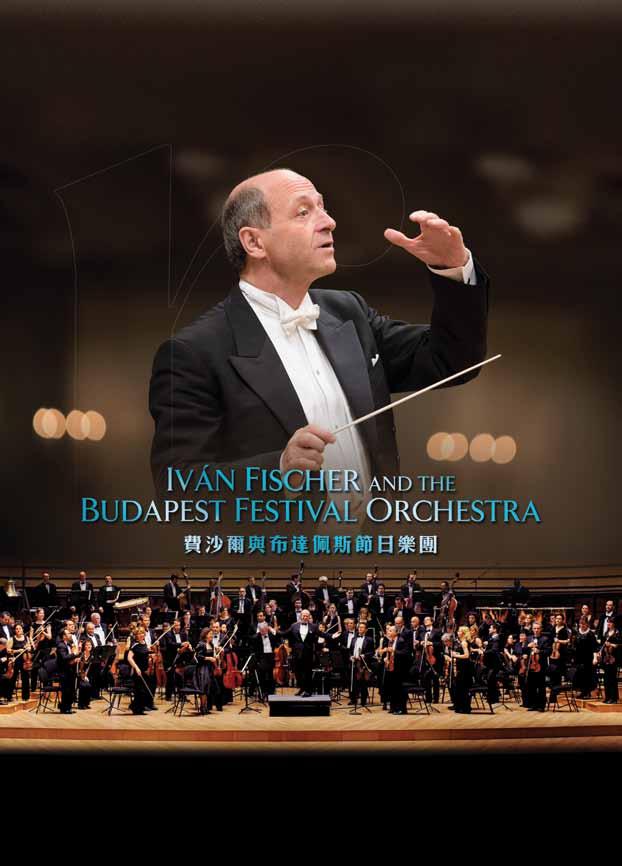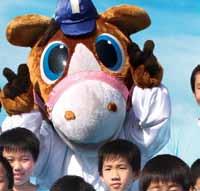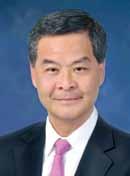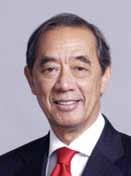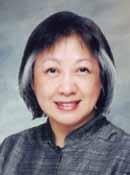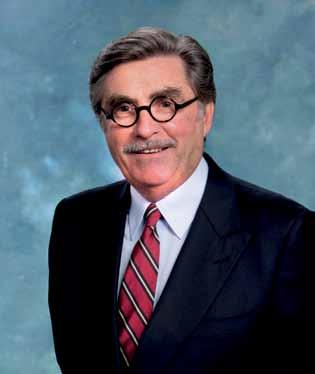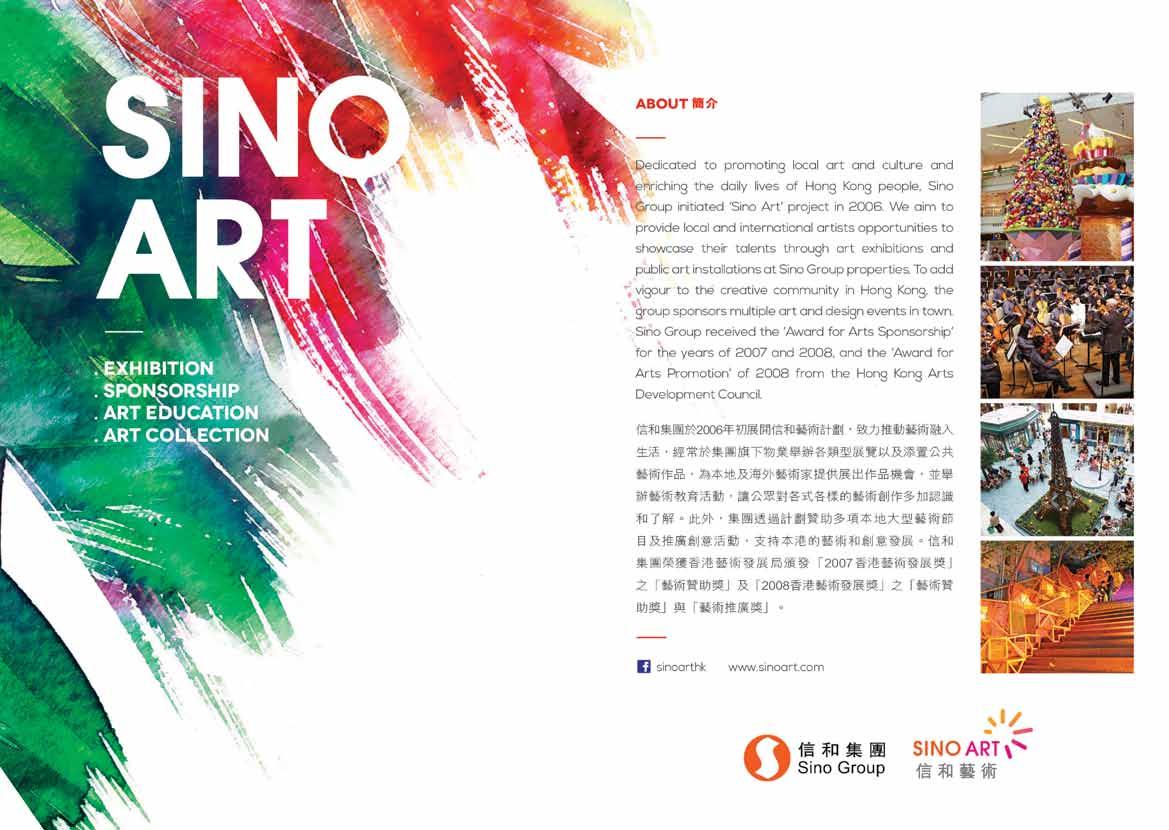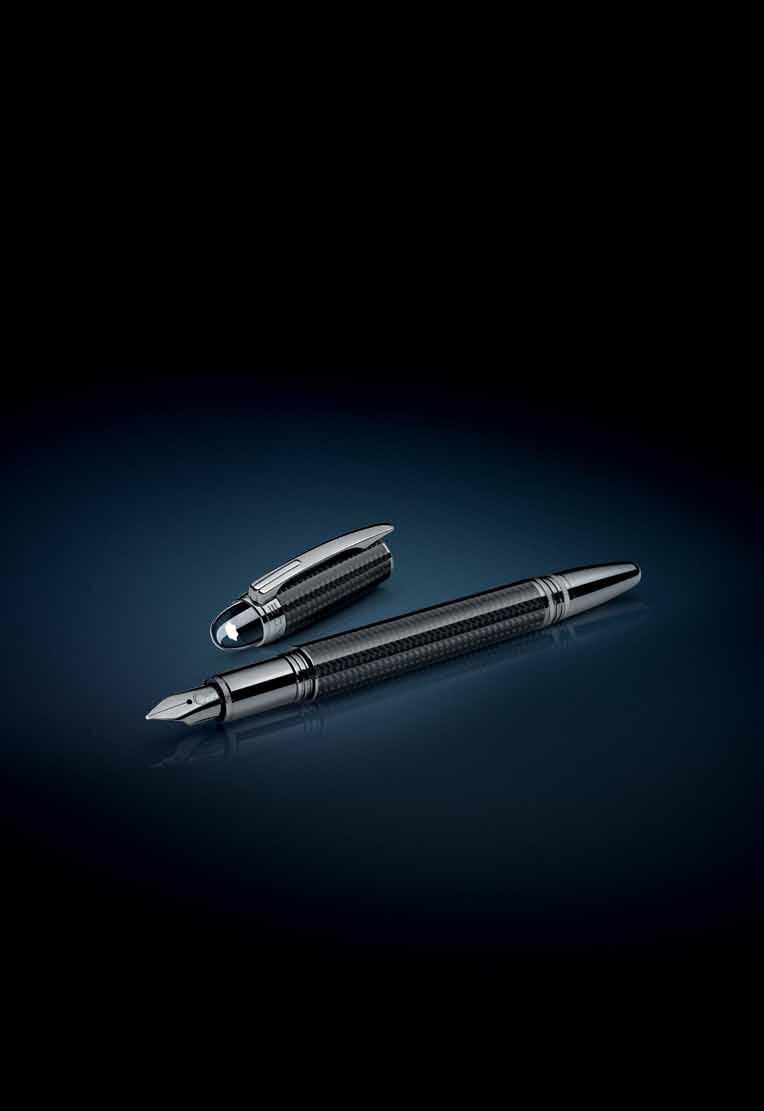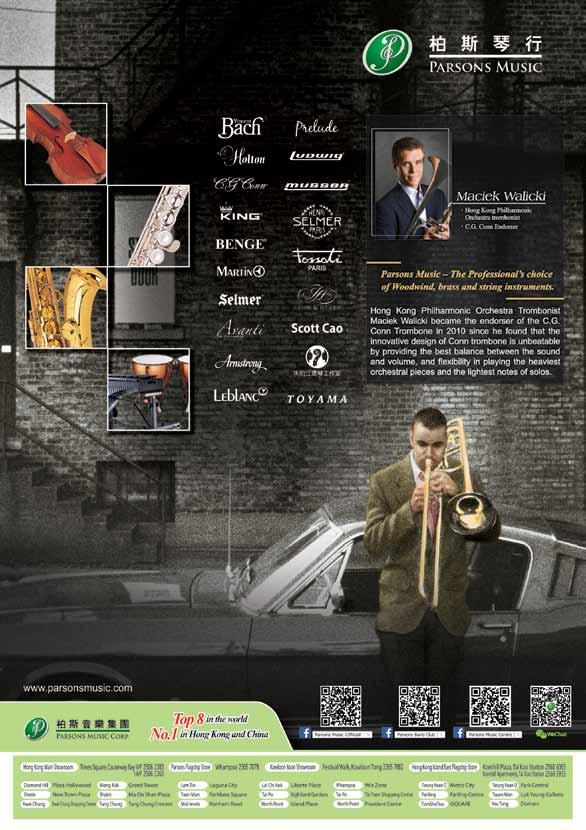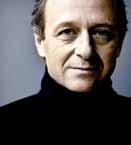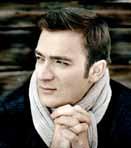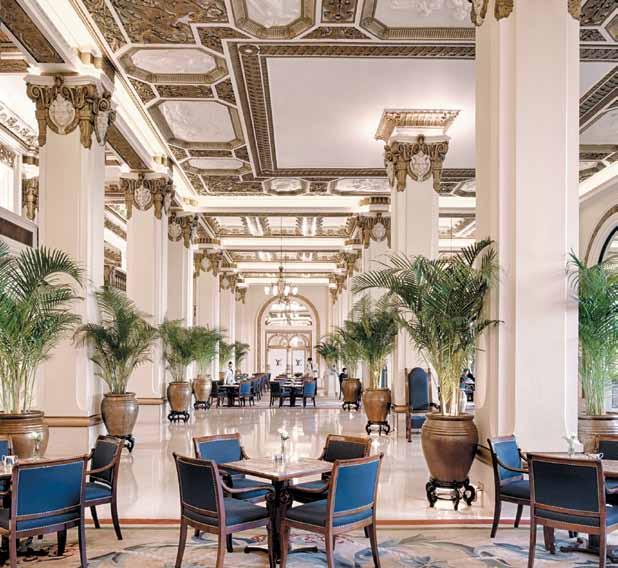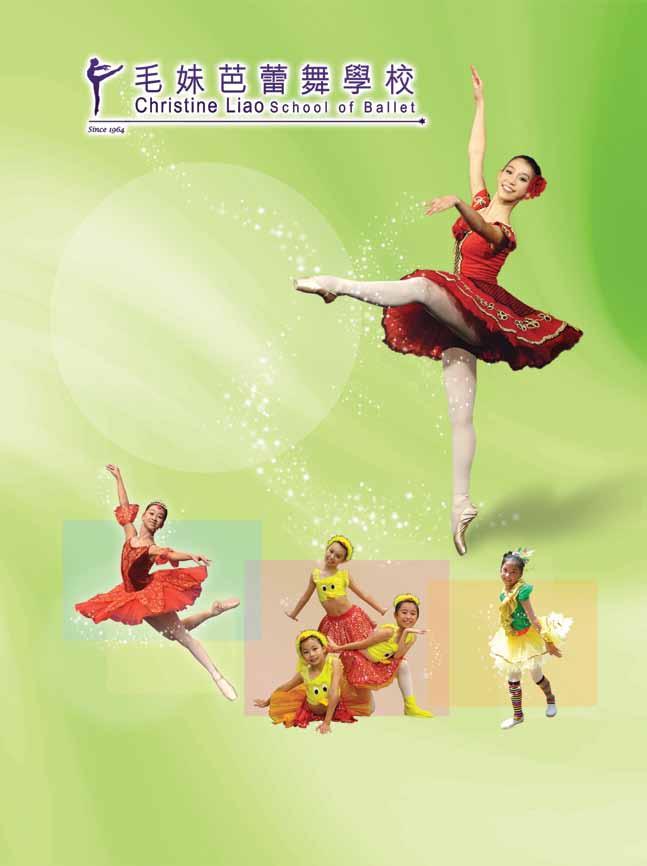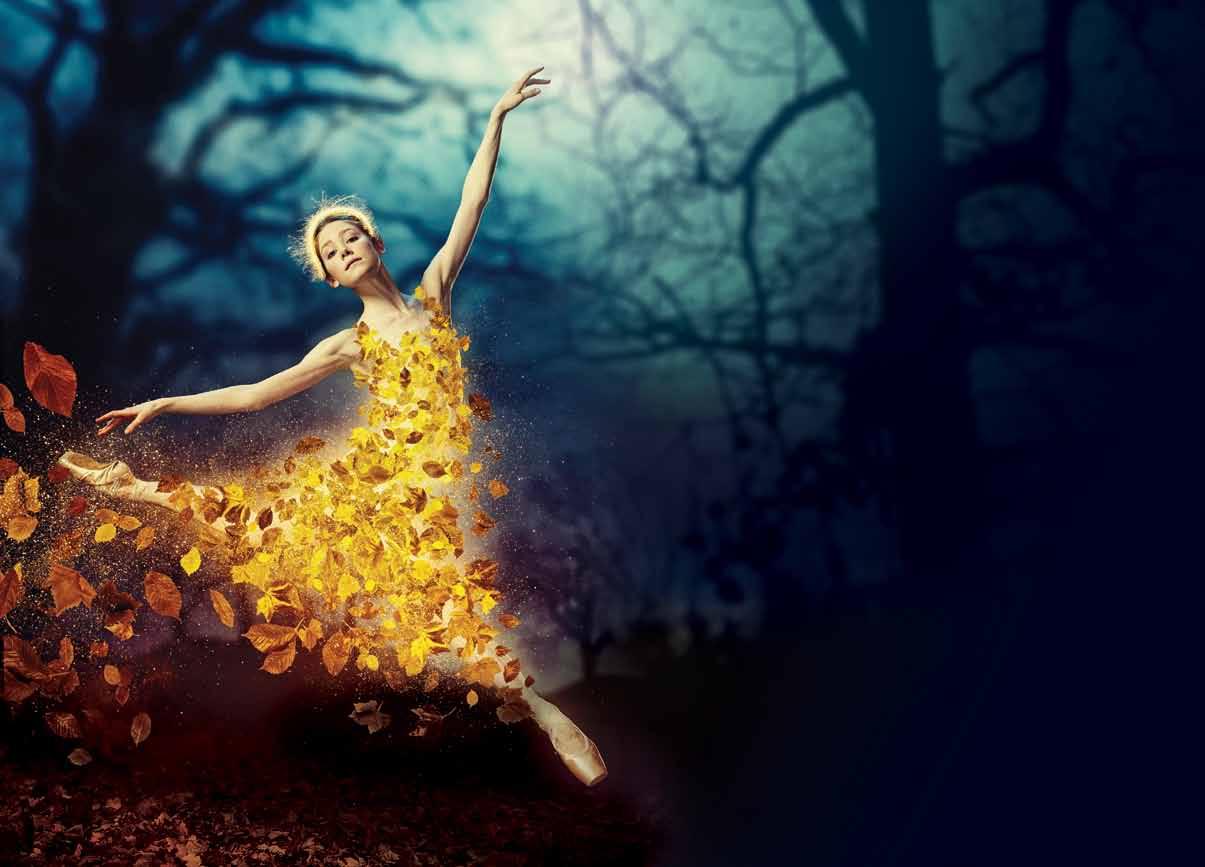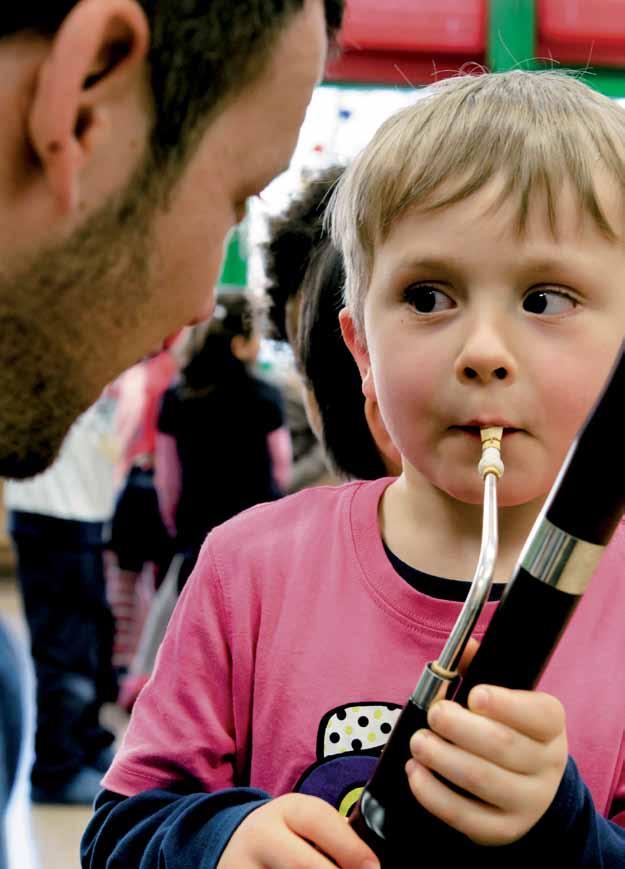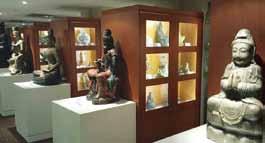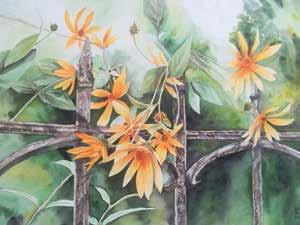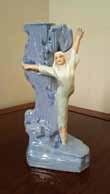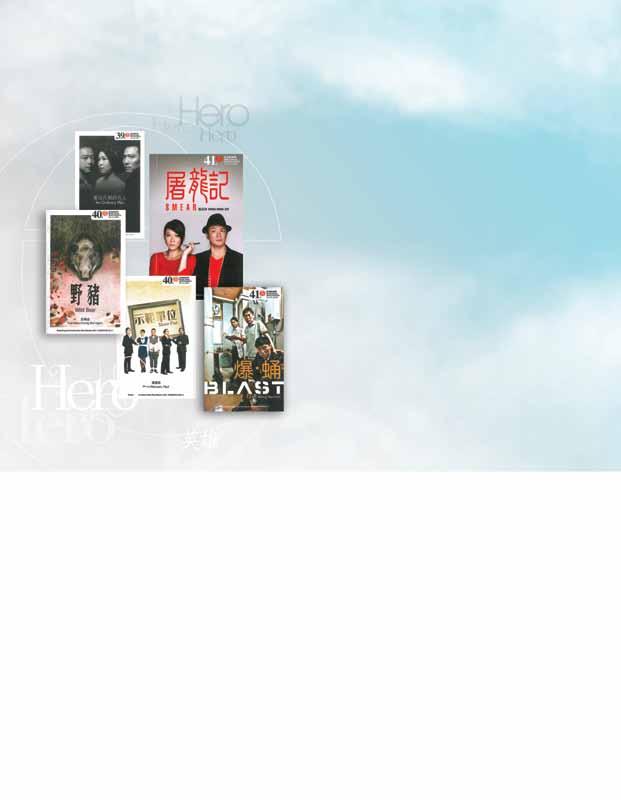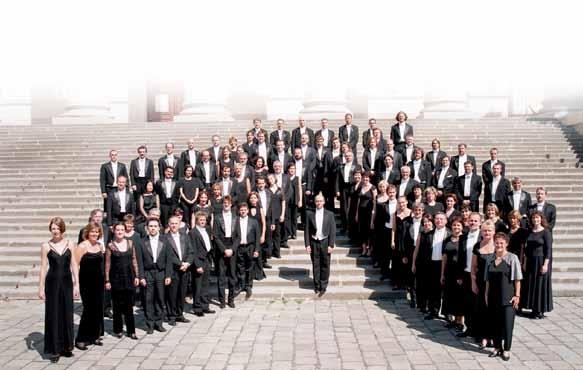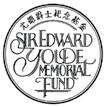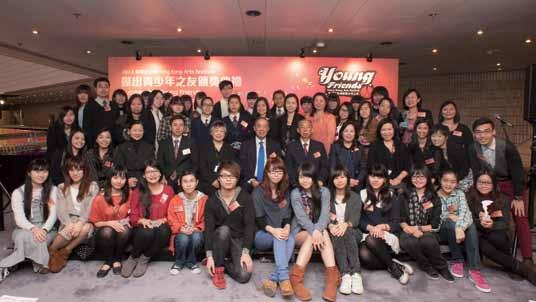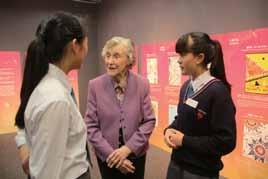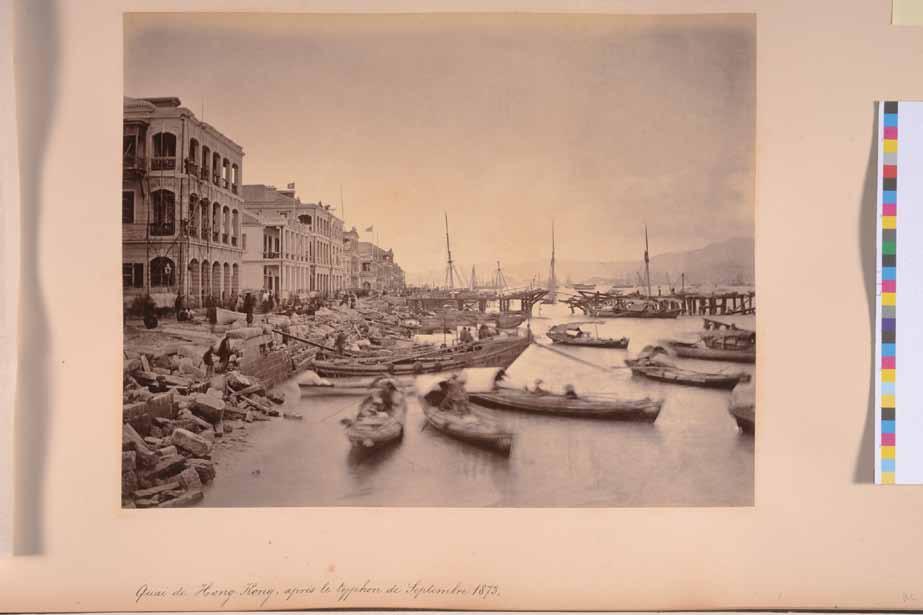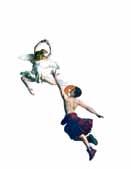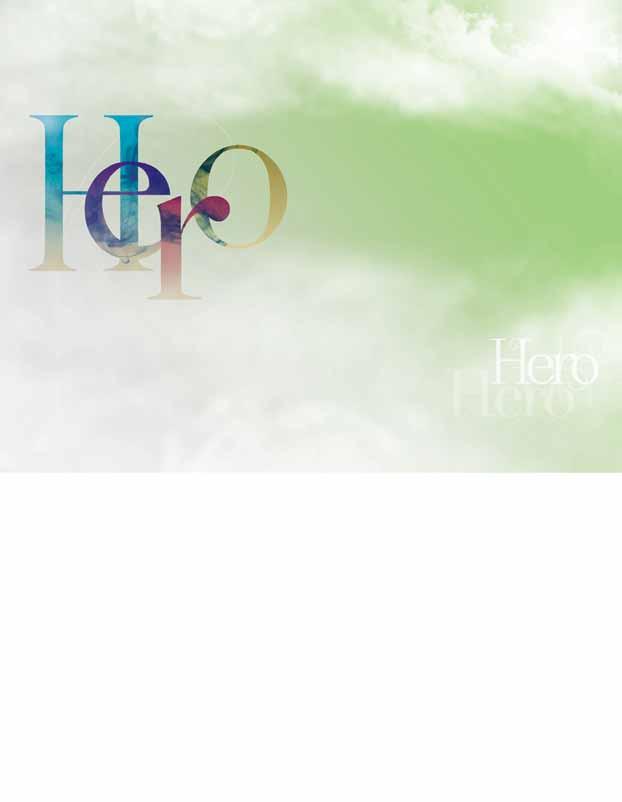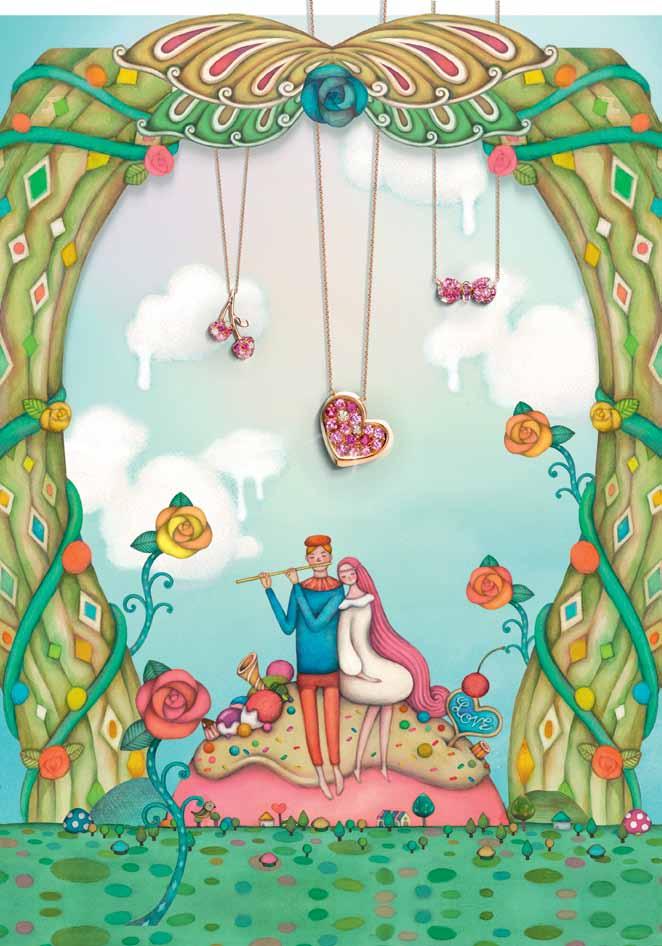香港藝術節
Hong Kong ArTS Fe STivAL ( HKAF)
香港藝術節 於 1973 年正式揭幕,是國 際藝壇中重要的文化盛事,於每年 2 、 3 月期間呈獻約 150 場演出及約 250 項「加料」和教育節目,致力豐富香港 的文化生活。
香港藝術節 是一所 非牟利機構,約三成 經費來自香港特區政府的撥款,約四成 來自票房收入,而餘下約三成則有賴各 大企業、熱心人士和慈善基金會的贊助 和捐款。
香港藝術節 每年呈獻眾多 國際演藝名 家 的演出,例如:芭托莉、卡里拉斯、 馬友友、格拉斯、馬素爾、沙爾、巴里 殊尼哥夫、紀蓮、史柏西、皇家阿姆斯 特丹音樂廳樂團、聖彼得堡馬林斯基劇 院基洛夫樂團及合唱團、巴伐利亞國立 歌劇院、紐約市芭蕾舞團、巴黎歌劇院 芭蕾舞團、翩娜.包殊烏珀塔爾舞蹈劇 場、雲門舞集、星躍馬術奇藝坊、皇家 莎士比亞劇團、莫斯科藝術劇院及北京 人民藝術劇院等。
香港藝術節 積極推介 本地演藝人才和 新晉藝術家 ,並 委約及製作 多套全新 戲劇、室內歌劇和當代舞蹈作品,甚 或出版新作劇本,不少作品已在香港 及海外多度重演。
香港藝術節 大力投資下一代的藝術教 育。 「青少年之友」 外展計劃成立 23 年來,已為約 700,000 位本地中學生 及大專生提供藝術體驗活動。藝術節每 年亦通過 「學生票捐助計劃」 提供近 9,000 張半價學生票。
香港藝術節 每年主辦逾百項深入社區的 「加料節目」,例如示範講座、大師班、 工作坊、座談會、後台參觀、展覽、藝 人談、導賞團等,鼓勵觀眾與藝術家互 動接觸。
HKAF, launched in 1973, is a major international arts festival committed to enriching the life of the city by presenting about 150 performances and 250 PLUS and educational events in February and March every year.
HKAF is a non-profit organisation, with about 30% of annual revenue from government funding, around 40% from the box office, and the remaining 30% from sponsorships and donations from corporations, individuals, and charitable foundations.
HKAF presents top international artists and ensembles, such as Bartoli, Carreras, Yo-Yo Ma, Glass, Masur, Chailly, Baryshnikov, Guillem, Spacey, the Royal Concertgebouw Orchestra, the Mariinsky Theatre and Valery Gergiev, Bavarian State Opera, New York City Ballet, Paris Opera Ballet, Tanztheater Wuppertal Pina Bausch, Cloud Gate Dance Theatre, Zingaro, Royal Shakespeare Company, Moscow Art Theatre, and the People’s Art Theatre of Beijing.
HKAF actively promotes Hong Kong’s own creative talents and emerging artists , and commissions , produces and publishes new works in theatre, chamber opera and contemporary dance, many with successful subsequent runs in Hong Kong and overseas.
HKAF invests in arts education for young people. In the past 23 years, our Young Friends has reached about 700,000 secondary and tertiary school students in Hong Kong. Donations to the Student Ticket Scheme make available close to 9,000 half-price student tickets each year.
HKAF organises over 100 Festival PLUS activities in community locations each year to enhance the engagement between artists and audiences. These include lecture demonstrations, masterclasses, workshops, symposia, backstage visits, exhibitions, meetthe-artist sessions, and guided tours.
Please contact the HKAF Development Dept for sponsorship opportunities and donation details.
電郵 Email 直綫 Direct Lines 網頁 Website dev@hkaf.org ( 852 ) 2828 4910 / 11 / 12 www.hk.artsfestival.org / en / partner
本場刊採用環保紙張印刷。This programme is printed on environmentally friendly paper Presents
6.3.2014 7.3.2014
演出長約 2 小時, 包括一節中場休息
Running time: approx. 2 hours incl. one interval
節目資料 P21 for programme details
香港文化中心音樂廳 Concert Hall, Hong Kong Cultural Centre
演出長約 1 小時 35 分鐘, 包括一節中場休息
Running time: approx. 1 hour 35 minutes incl. one interval
節目資料 P33 for programme details
敬請關掉所有響鬧及發光裝置,請勿擅自攝影、錄音或錄影,多謝合作。 Please switch off all sound-making and light-emitting devices. Unauthorised photography or recording of any kind is strictly prohibited. Thank you for your co-operation.
www.hk.artsfestival.org 網上追蹤香港藝術節 Follow the HKArtsFestival on
布達佩斯節日樂團 Budapest Festival Orchestra
布達佩斯節日樂團由伊凡.費沙爾 及佐爾登.高西斯於 1983 年創立, 是世界頂尖樂團之一。除了樂團音 樂會及室樂系列音樂會外,樂團亦 設有專門演奏古樂器的巴羅克樂團, 以及專門演奏當代音樂的當代合奏 團。獲選於半年一度的山度.域赫 比賽的樂團成員,在海頓-莫扎特音 樂會系列中擔任獨奏演奏協奏曲, 指揮是樂團首席客席指揮加博爾. 塔卡奇-納吉。
樂團是布達佩斯藝術宮策略伙伴,兩
2003 年攜手舉辦「歐洲橋樑」 音樂節。每年二月樂團亦會跟藝術宮 舉行特選作曲家「馬拉松」,以及演 出由音樂總監費沙爾執導兼指揮的歌 布達佩斯節日樂團每年在布達佩斯舉 40 場音樂會,並定期在匈牙 利其他城市演出,把一系列國際知名 的藝術家帶給匈牙利觀眾。此外,布 達佩斯節日樂團定期在卡內基音樂 廳、林肯中心、維也納演奏廳等主要 音樂演出場地演出;樂團與費沙爾也 是琉森、愛丁堡、聖塞巴斯蒂安等主 要音樂節的常客,樂團也再度獲邀在 紐約莫扎特音樂節中演出。
樂團至今灌錄了超過 50 張唱片,並 贏得兩次《留聲機唱片大獎》,分別 為巴托克的《神奇的滿大人》( 1998 年)及馬勒第二交響曲;樂團更憑
Founded in 1983 by Iván Fischer and Zoltán Kocsis, the Budapest Festival Orchestra (BFO) has established itself as one of the leading orchestras of the world. Besides the orchestral concerts and a chamber-music series, the Orchestra hosts a baroque ensemble playing on period instruments, and a contemporary ensemble performing music of our time. Orchestra members chosen in the biannual Sándor Végh competition perform concertos as soloists in the Haydn-Mozart Plus concerts conducted by the BFO’s Principal Guest Conductor, Gábor Takács-Nagy.
The BFO is the strategic partner of the Palace of Arts in Budapest. Together they launched the “Bridging Europe – Európai hidak” festival in 2013. Every February the BFO and the Palace of Arts jointly organise the single-composer “marathon” and an opera production directed and conducted by Music Director Iván Fischer.
The BFO gives over 40 concerts in Budapest and regularly performs in other Hungarian cities, bringing an array of internationally acclaimed artists to the Hungarian audiences. The BFO regularly performs in major musical centres like Carnegie Hall, Lincoln Center, Konzerthaus Wien, and others. The BFO and Fischer are regular guests in major music festivals such as the Lucerne, Edinburgh and San Sebastian Festivals. The BFO is also a returning guest at New York’s Mostly Mozart Festival.
馬勒第一交響曲的唱片在 2013 年 獲艾美獎提名。布達佩斯節日樂團 在 2006 年獲頒荷蘭音樂大獎,並在 2008 年獲《留聲機》雜誌的頂尖樂 評人選為世界最佳樂團第九位。
布達佩斯節日樂團自 1992 年起以非 牟利基金營運,樂團活動經費由匈牙 利政府人力資源部及布達佩斯市政府 支持。
The Budapest Festival Orchestra has been operating as a non-profit foundation since 1992. The activities of the BFO are supported by the Hungarian Ministry of Human Resources and the Budapest City Council.The Orchestra has more than 50 recordings. The BFO won two Gramophone awards: one for Bartók’s The Miraculous Mandarin in 1998 and one for the recording of Mahler’s Symphony No 2. The BFO was a Grammy award nominee for 2013 for the recording of Mahler’s Symphony No 1. The BFO also received the Dutch Music Award in 2006 and in 2008 was voted as 9th best orchestra in the world by leading music critics (Gramophone).
The BFO has been operating as a nonprofit foundation since 1992. The activities of the BFO are supported by the Hungarian Ministry of Human Resources and the Budapest City Council.
藝術節加料節目
大號大師班 Tuba Masterclass with Jósef Bazsinka
5.3.2014(三)晚上 7:45-9:45
西灣河文娛中心文娛廳 布達佩節日樂團的大號首席約瑟夫•波仙 卡將示範演奏,讓大家體會到大號不但在 樂團合奏中優美動聽,更是美妙的獨奏樂 器。
英語主講
更多加料節目信息請參閱加料節目指南或瀏覽網站: www.hk.artsfestivalplus.org
5.3.2014 (Wed) 7:45-9:45pm
Cultural Activities Hall, Sai Wan Ho Civic Centre Jósef Bazsinka, principal tuba of the Budapest Festival Orchestra, will show you that the tuba not only sounds great in an ensemble but also makes a great solo instrument.
In English
Find out more about Festival PLUS in the PLUS Programme Guide or at www.hk.artsfestivalplus.org
伊凡.費沙爾
Iván Fischer
音樂總監
Music Director
費沙爾是布達佩斯節日樂團的創辦人 兼音樂總監,他為樂團帶來一系列新 形式的音樂會,包括為小朋友而設的 「可可音樂會」、為學生而設的「午 夜音樂會」、不公佈曲目的「驚喜音 樂會」、他向觀眾作解說的「一元音 樂會」,以及為吸引布達佩斯大眾而 設的戶外音樂會。費沙爾創辦了多個 音樂節,包括以巴羅克音樂為主題的 布達佩斯夏日音樂節及布達佩斯馬勒 音樂節。
費沙爾曾以客席指揮的身份跟多個世 界優秀樂團合作,包括柏林愛樂樂團、 皇家阿姆斯特丹音樂廳樂團,以及紐 約愛樂樂團和克里夫蘭管弦樂團等美 國主要樂團。
費沙爾曾為肯特歌劇院和里昂歌劇院 的音樂總監,亦曾在華盛頓國家交響 樂團擔任首席指揮。他同時兼任柏林 音樂廳的音樂總監,以及柏林音樂廳 樂團的首席指揮。
費沙爾是匈牙利馬勒協會的創辦人, 也是英國高大宜學院的贊助人。他曾 獲頒多個獎項,包括匈牙利共和國總 統頒發的金牌獎、匈牙利藝術界最高 榮譽的卡索斯獎、英國皇家愛樂大獎、 荷蘭歐曼蒂獎等。2013 年他獲倫敦皇 家音樂學院頒授為榮譽會員。
Fischer is founder and Music Director of the BFO. For the Orchestra, he has introduced new types of concerts including the “cocoaconcerts” for young children, “midnight music” concerts for students, “surprise” concerts where the programme is not announced, “one forint concerts” where he talks to the audience and open-air concerts in Budapest drawing large audiences. He has founded several festivals, including a summer festival in Budapest on baroque music and the Budapest Mahlerfest.
As a guest conductor Fischer has worked with the world’s finest orchestras including the Berlin Philharmonic, the Royal Concertgebouw Orchestra, and leading US symphony orchestras such as the New York Philharmonic and the Cleveland Orchestra. Fischer has served as music director of Kent Opera and Lyon Opera, principal conductor of National Symphony Orchestra in Washington DC. He is also music director of the Konzerthaus Berlin and principal conductor of the Konzerthausorchester Berlin.
Fischer is a founder of the Hungarian Mahler Society, and Patron of the British Kodály Academy. He has received numerous accolades including the Golden Medal Award from the President of the Republic of Hungary; the Kossuth Prize, Hungary’s most prestigious arts award; the Royal Philharmonic Award; and the Dutch Ovatie prize. He was awarded Honorary Membership of the Royal Academy of Music in London in 2013.
雷諾德.卡普森
Renaud Capuçon
小提琴
Violin
卡普森 1976 年出生於尚貝里,14 歲 入讀巴黎國立高等音樂學院。後來他
移居到柏林,跟隨湯馬士.布蘭迪斯 和埃昔.史頓學習,更獲頒柏林藝術 學院獎。1997 年獲克勞迪奧.阿巴度
邀請成為馬勒青年管弦樂團的樂團首 席,帶領了樂團三個夏季。
卡普森曾與世界頂尖樂團合作演出協
奏曲,包括柏林愛樂樂團和波士頓交 響樂團等,同時他亦經常以獨奏家身
份巡迴演奏,在隨後的樂季將與鋼琴
家法蘭克.巴利演奏貝多芬全套小提 琴奏鳴曲。
卡普森熱心演奏室樂,曾與阿嘉莉殊、
巴倫波英、布朗夫曼等音樂家合作, 並曾聯同的弟弟、大提琴家戈蒂埃.
卡普森於愛丁堡藝術節、倫敦莫扎特
音樂節、普羅旺斯音樂節等主要音樂 節演出。
卡普森為維京唱片獨家灌錄唱片,他
最新灌錄的作品是與鋼琴家法蘭克. 巴利演繹貝多芬小提琴及鋼琴奏鳴 曲。他亦曾與鹿特丹交響樂團及指揮
雅尼克.聶澤-賽金合作灌錄貝多芬 和康戈爾德的協奏曲。
簡歷中譯:陳楚珊
Born in Chambéry in 1976, Capuçon began his studies at the Conservatoire National Supérieur de Musique de Paris at 14. He later moved to Berlin to study with Thomas Brandis and Isaac Stern, and was awarded the Prize of the Berlin Academy of Arts. In 1997, Capuçon was invited by Claudio Abbado to become concertmaster of the Gustav Mahler Jugendorchester, which he led for three summers.
Capuçon has played concerti with the world’s leading orchestras such as the Berlin Philharmonic, the Boston Symphony, and many others. Capuçon tours extensively as a solo recitalist and will perform complete cycles of the Beethoven violin sonatas with pianist Frank Braley during the coming seasons.
Capuçon has a great commitment to performing chamber music and has worked with Argerich, Barenboim, Bronfman, and others, as well as with his brother and cellist Gautier Capuçon at major music festivals such as Edinburgh, London (Mostly Mozart), Aix-en-Provence, and others.
Capuçon records exclusively for Virgin Classics. His most recent recording was of Beethoven Sonatas for violin and piano with Frank Braley. He also recorded the Beethoven and Korngold concertos with the Rotterdam Philharmonic and Yannick NezetSeguin.
We Teach
All levels of ballet of
• Royal Academy of Dance (RAD)
• The Commonwealth Society of Teachers of Dancing (CSTD)
• Imperial Society of Teachers of Dancing (ISTD)
• The Australian Conservatoire of Ballet (ACB)
• Beijing Dance Academy (BDA)
* Competitions
* Performances
6.3.2014
莫扎特
G 小調第 40 交響曲,K550
極快板
行板
小步舞曲
甚快板
Wolfgang Amadeus Mozart (1759-1791)
Symphony No 40 in G minor, K550 Molto allegro Andante
Menuetto Allegro assai
中場休息 Interval
布魯克納
D 小調第 9 交響曲,WAB109
莊嚴而神秘的
詼諧曲-輕快,有活力;三重奏-急速地 慢板-緩慢地,莊嚴地
Anton Bruckner (1824-1896)
Symphony No 9 in D minor, WAB109
Feierlich, misterioso
Scherzo. Bewegt, lebhaft; Trio. Schnell Adagio. Langsam, feierlich
Headquarter : Room 1201, 12/F, Star House, Tsim Sha Tsui, Kowloon, Hong Kong Tel: 2736 6118, 2736 6666
Branch : Room 1308, 13/F, Tower 1, Grand Central Plaza, Shatin, New Territories, Hong Kong Tel: 2688 0360
Location : Tsim Sha Tsui, Kwun Tong, Hung Hom, Causeway Bay, Pok Fu Lam, North Point, Shatin, Tai Po, Tuen Mun, Yuen Long, Kwai Tsing
Website : www.christineliaoballet.com.hk Email: cliao@biznetvi gator.com
Pieces and their order of performance are subject to change
莫扎特: G 小調第 40 交響曲, K550
Mozart: Symphony No 40 in G minor, K550
莫扎特最後三首交響曲在 1788 年夏 天以短短六星期完成,當中蘊含的 細膩情感,並非簡單的大調小調二 分法所能言盡的。
莫扎特的交響曲作品中只有兩首小
調,而兩首都是 G 調,這當然並非 偶然, G 小調對莫扎特來說是深深 悲哀的,在第 40 交響曲中 莫扎
特離世前第二首交響曲遺作,這份 情感牽繫令作品帶着矛盾的美,當
中危急的、悲傷的表達,對比着安
撫人心的形式,居然完美而恬淡地 達到平衡,堪稱古典樂的模範。
作品的定性眾說紛紜,用舒曼的話,
這是一首「輕靈的、富有希臘式高 雅的作品」,用較主觀的角度,我 們可以欣賞作品「惡魔般」的激情,
甚至聽到瀕臨自殺的絕望。此外, 同樣迷離不清的也包括樂曲的創作 緣起。
沒有確實證據告訴我們樂曲是受聘 而作,有說莫扎特寫這三首交響曲 遺作只為留名後世,但近代學者提 出疑點,研究莫扎特的音樂學者薩 斯洛認為,就以莫扎特曾修改第 40 交響曲一事,足以證明此曲曾在他
在生時演出,薩斯洛寫道:「若果
不是為了某一次演出,莫扎特不會
費勁去加插單簧管部分,並重寫長
笛及雙簧管來加以襯托。」
The range of emotions encompassed by Mozart’s great final trilogy of symphonies –all written in the space of six weeks in the summer of 1788 – is far subtler than the simple polarities of “major” and “minor” would suggest.
To be sure, the fact that Mozart wrote only two symphonies in the minor key (both in G minor) is of significance. Yet the depth of pathos he seems to have associated with G minor leads to a paradoxical beauty in the second-to-last symphony Mozart completed. No 40 demonstrates a perfect but rarefied balance of urgent, tragic expression and reassuringly pleasing form: the archetype of Classicism.
Depending on our preferences, we might be inclined to share Schumann’s famous assessment of K550 as a work of “weightless, Hellenic grace” or, in a more subjective mode, to prize its “demonic” passions or even to perceive a “suicidal” desperation. It therefore seems all the more fitting that the practical circumstances of its creation remain shrouded by uncertainty.
There is no concrete evidence of a commission, yet recent scholarship has questioned the myth that Mozart was writing only for posterity when he composed his final trilogy of symphonies. The fact that he revised his scoring for No 40, writes Neal Zaslaw, can be taken as reasonable evidence that this music was performed
無可置疑的是樂曲充滿新穎破格的 主意,例如開始時以簡短的引子伴 奏,就大膽地打破了當時交響曲要 先聲奪人的慣例。在第一主題中, 音型清晰的「嘆息」半度不單立即 引動聽眾的情感,更成為樂曲的主 幹,賦予交響曲統一的樂思,富生 命力地以不同形態在全曲各處出現: 在〈行板〉細緻的音色和室樂般的 平穩中,這「嘆息」的音型在高貴 的織錦中滑過;在終曲高低起伏的 主題高潮中亦見其蹤影;這以樂思 貫徹始終的手法為貝多芬立了先例。
在節奏方面莫扎特亦有所創新,第 三樂章結合彬彬有禮的小步舞曲和 傳統的卡農規格,帶出激烈的切分 音。就樂曲的整體而言,終樂章平 衡了第一樂章的悲傷;莫扎特在離 世前幾年專注於複音音樂,在此曲 表現出扣人心弦的動力,顯示出他 創作功力的細膩;在一百年後,作 家荷夫曼在評論交響曲式為最高等 器樂的同時,特別表彰莫扎特的交 響曲「預視了無限可能」。
during his lifetime: “Mozart would hardly have gone to the trouble of adding the clarinets and rewriting the flutes and oboes to accommodate them had he not had a specific performance in view.”
What is beyond dispute is that K550 teems with bold and unusual ideas. It opens, for example, with a brief introductory accompaniment right in the middle of things: a daring departure from the forceful call to attention that conventionally launches a symphony of this era. The sighing half-step that figures so prominently in the first theme evokes an immediately emotive response; at the same time, it performs a key structural role by unifying the Symphony as an organically recurrent idea, appearing in many guises throughout – and with an obsessiveness than anticipates Beethoven. Listen for this “sigh” in the graceful embroidery running through the delicate colors and chamber-like poise of the Andante or at the highest point of the finale’s up-and-down rocket-like theme.
Mozart also innovates on the rhythmic front. The third movement weds the polite dance of the minuet with the oldfashioned principle of the canon, introducing syncopations of fierce intensity. Overall, the finale stands as a counterweight to the pathos of the first movement. The polyphonic thinking of Mozart’s final years here produces a thrilling momentum that is also a wonder of intricate compositional artistry. In the century to follow, the writer E.T.A. Hoffmann would declare the symphonic genre to represent “the highest type of instrumental music,” singling out Mozart’s symphonies for their “anticipation of the infinite.”
率先披露 Programme Highlights
Dutch National Ballet Cinderella
Los Angeles Philharmonic / Gustavo Dudamel
The Bolshoi Opera and Bolshoi Ballet
莫斯科大劇院歌劇團及芭蕾舞團 Staatskapelle Dresden / Christian Thielemann
德累斯頓國家管弦樂團/泰利曼 《金蘭姊妹》 The Amahs
電影《桃姐》編劇李恩霖打造香港原創戲劇
Cassandra Wilson celebrates Billie Holliday’s centenary Barefoot Divas Indigenous voices from Australia, NZ & Papua New Guinea
布魯克納: D 小調第 9 交響曲, WAB 109
Bruckner: Symphony No 9 in D minor, WAB 109
布魯克納最後的交響曲,寫作時期
斷斷續續由 1887 年伸延到 1896 年, 中間間插着其他創作,但最終都沒 有完成。 1896 年布魯克納逝世時, 結尾的第四樂章仍是草稿;作品後 來在 1903 年首演。布魯克納是虔誠 的天主教徒,把樂曲獻給他「敬愛 的主」,可是在超凡神聖的樂段之 間,還是流露出一個垂死的人的疑 惑與苦楚。
一如莫扎特的安魂曲,每當死神插 手令作曲家無法完成他們的創作宏 願,未完成的遺作往往引來傳言紛 紛。有作曲家嘗試用不同方法來「完 成」布魯克納的這首交響曲,例如
依草稿創作第四樂章,或以布魯克 納的另一首歌詠作品《讚美頌》來 代替。
其實單憑現存的三個樂章,第 9 交 響曲已經能完整地勾畫出一個冒險 旅程,兩首甚具份量的樂章形成了
樂曲的框架,中間的詼諧曲帶着原 始的力量,發揮橋樑作用。在是晚 演出中,指揮費沙爾選取了 1932 年 由奧雷爾編曲的三樂章原版本。
樂曲起初的深鬱樂段,奇妙地描繪 出天地初開的景象,認識貝多芬第 9
交響曲(亦是 D 小調作始)的聽眾 都能在這裏找到其深邃的影響,但
布魯克納把從渾沌中創造宇宙的手
法卻與貝多芬不同。當主樂思好像
Anton Bruckner’s final symphony, which occupied him from 1887-96 (with interruptions for other projects), was left unfinished. Its projected fourth and final movement existed only as sketches when the composer died in 1896, and it was premiered posthumously, in 1903. The devoutly Catholic Bruckner dedicated the score to his “dear God”, yet the music at times expresses the moments of doubt and agony of a dying man, along with passages of otherworldly serenity.
As with Mozart’s Requiem, a good deal of lore has grown around the fact that these are “final” works, with death intervening to prevent their respective composers from rounding out their respective artistic visions. There have even been attempts by later composers to “complete” the work by creating a new fourth movement based on the sketches or by performing Bruckner’s independent choral setting of the Te Deum as a finale.
Yet even with its existing three movements, the Ninth traces an epic journey that feels complete on its own terms. (For this performance Fischer has opted to use the original three-movement version edited by Alfred Orel in 1932.) Two massive movements frame the work, while a scherzo infused with a kind of primal energy serves as the transition between them.
The Ninth opens with a brooding passage that represents one of the most extraordinary
剛剛冒起,新的片段湧現,直至巨 大響亮的主題藉一股強大的能量現 身,它跨越 D 主音之上的八度加半 音的寬度,成為樂曲巨大建構的特 色;兩個主題音組橫跨整首第一樂 章的三分一,在樂章的其餘部分, 這些樂思模塊重整重構,就像要解 構原始宇宙的謎團一樣。
與當時理察.史特勞斯風行一時、 濃得像油畫的風格相比,雖然布魯 克納動用了龐大的樂團,他的譜法 就像清新簡樸的壁畫,即使在第二 主題組情感最豐溢之處,內聲部的 裝飾層次仍是簡約的,沒有任何多 餘成分。布魯克納在並列和休止的 運用,成為了往後作曲家實驗空間 音樂的先驅。結尾縈繞不散,把主 音送到不協和的衝突,樂章終結於 引人入勝的空洞。
詼諧曲也是 D 小調,同樣帶出強烈 的不協和,從主題節奏多次的重複, 有些人聽到了死神的舞蹈;原始的 能量承接第一樂章渾沌的宇宙,鮮 明強烈的粗野,令人想起在史達拉 汶斯基的《春之祭》中,創造與破 壞的力量互相衝擊。在這個脈絡中, 就像反重力一樣生出升 F 大調的三 重奏,弦樂與管樂閃爍的對話,真 假難分,並列於詼諧曲如雷的鳴響, 帶出奇異的輕靈。
在〈慢板〉中,樂曲的主觀和客觀 世界巧妙地結合,在第一樂章神祕 宇宙的大氣氛下,布魯克納並置着 個人化的痛苦和飄渺的渴望;開首
evocations of genesis. Anyone who knows Beethoven’s Ninth (also beginning in D minor) will recognise its profound influence, yet Bruckner’s approach to a cosmos emerging from nothing is actually quite different. Just when the main idea seems to be emerging, new fragments appear until, with a vast summoning of energy, a theme of gigantic dimensions peals forth. Its wide span encompasses an octave and the half-step above the tonic D and is characteristic of the Ninth’s colossal landscape. Two additional thematic groups extend over one-third of the first movement’s expanse. The rest of the movement reconfigures and retraces these blocks of musical ideas as if to enact a process of unravelling primordial mysteries.
Despite his relatively large orchestra, Bruckner’s scoring is an austere fresco compared with the rich oils with which Richard Strauss was creating a sensation at the same time. Even the most lyrical effusion (the music of the second subject group), with its decorative inner lines, is purged of any excess. Bruckner’s juxtapositions and silences point ahead to composers who will experiment with “spatial” music. A haunting coda sets off the tonic in a dissonant clash, though the movement ends with a curious hollowness.
The scherzo, also in D minor, likewise brings powerful dissonance into the foreground. Some hear in the massive repetitions of the main theme’s rhythm a kind of dance of death. Yet its primal energy is very much in keeping with the elemental, cosmic world of the first movement, with an insistently seismic barbarity that also brings the
主題調性的伸展,預示了馬勒甚至 是荀白克等後輩的手法,上升的音 型又令人想起華格納《帕西法爾》 的「聖杯」動機,亦如《帕西法爾》, 在這〈慢板〉中時間變成空間。在 樂章達到終極平靜之前,布魯克納 築起令人傷心的高潮,由銅管樂推 動,之後長長的靜默同樣令人驚心。
這就是死亡的一瞬?布魯克納的音 樂營造了震撼的衝突,往後並不都 是靜默。布魯克納稱終曲為「別了, 生命」,氣氛是一片莫名的鎮靜。
樂曲以華格納低音號的四重奏奏出 布魯克納的第 7 和第 8 交響曲,以 回顧他這兩首巔峰之作,雖然第 9 交響曲是未完成的作品,但仍能以 令人欣慰的定局作結。
ambiguous forces of Stravinsky’s Rite of Spring to mind, in which creative and destructive impulses intertwine. Framed by this context, the gravity-defying F-sharp major Trio, with its flickering dialogue between strings and winds (or is it mocking?), suggests an odd lightness when juxtaposed against the thunder strokes of the scherzo proper.
In the Adagio , the objective and subjective worlds of the Ninth join together in wondrous balance. Here Bruckner juxtaposes against the sense of universal mysteries from the first movement a kind of individual anguish, a perspective of uncertain yearning. The stretched tonality of the opening theme foreshadows Mahler and even Schoenberg, while the rising figure that is then added alludes to the Grail motif from Wagner’s Parsifal . And much as in Parsifal , in the Adagio “time becomes space”. But before the movement can attain a state of ultimate calm, Bruckner builds to a harrowing, brasspowered climax. Just as terrifying is the long silence that fills it afterward.
Is this the moment of death? Bruckner’s music forces a shattering confrontation. But the rest is not silence. What follows in the coda is the true “farewell to life” (the composer’s own phrase), music of ineffable return and composure. Along the way, quotations by the quartet of Wagner tubas from the Eighth and Seventh Symphonies look back to two of Bruckner’s greatest achievements. Even though the Ninth remained unfinished, it comes to rest with a reassuring finality.
7.3.2014
鮑羅廷
〈韃靼舞曲〉選自《伊戈王子》
格拉祖諾夫
A 小調小提琴協奏曲,作品 82
中板
稍慢的行板
快板
Alexander Borodin (1833-1887)
Polovtsian Dances from Prince Igor
Alexander Glazunov (1865-1936)
Violin Concerto in A minor, Op 82
Moderato
Andante sostenuto
Allegro
小提琴:雷諾德•卡普森 Violin: Renaud Capuçon
中場休息 Interval
貝多芬
A 大調第 7 交響曲,作品 92
稍稍遲延的—極快板
稍快板
急板—非常的急板(三重奏)
有活力的快板
Ludwig van Beethoven (1770-1827)
Symphony No 7 in A, Op 92
Poco sostenuto – Vivace
Allegretto
Presto – Assai meno presto (trio)
Allegro con brio
是晚演出曲目及次序或有更改
Pieces and their order of performance are subject to change
鮑羅廷 : 〈韃靼舞曲〉,選自《伊戈王子》
Borodin: Polovtsian Dances from Prince Igor 鮑羅廷並非多產,卻領導着一群致 力創作正宗俄羅斯音樂的作曲家, 他們要擺脫西歐音樂的規範,注重 業餘創作熱情多於正統音樂教育, 而鮑羅廷自己就是學醫及化學的。
雖然鮑羅廷用於創作的空餘時間不 多,但憑着《伊戈王子》,他成為 俄羅斯器樂音樂的先鋒,並標示着 俄國歌劇發展的重要里程。《伊戈 王子》改編自佚名的斯拉夫史詩, 敘說着俄羅斯人和中亞大草原的韃 靼戰士鬥爭的傳說,故事啟發鮑羅 廷去研究怎樣從民間音樂中,尋找 古代俄羅斯的感覺。鮑羅廷在 1887 年猝逝,未能完成《伊戈王子》, 林姆斯基-高沙可夫和他的學生格 拉祖諾夫,從他留下的草稿着手, 整理並編排出可供演出的版本。
《伊戈王子》的故事發生在 1185 年, 主角伊戈王子的國土約位於現今的 烏克蘭,他帶領軍隊對抗孔察可汗 和其姦淫擄掠的韃靼士兵,怎料戰 敗被俘,後來成功逃脫,並捲土重 來,得到最後的勝利。
韃靼舞曲用戲劇性手法,突出入侵 者韃靼的「異國」文化和孔察可汗 對伊戈王子勇氣的仰慕,在俘虜俄 國人後,可汗命令奴隸表演舞蹈來 娛樂王子和他的部下,夢幻迷人的 引子帶出充滿東方色彩的溫柔旋律, 是聽眾耳熟能詳的,後來百老匯音
Alexander Borodin completed only a small body of work but was an important member of the circle of artists who wanted to develop a way of writing authentically Russian music that was distinct from Western European conventions. They preferred the passion of the amateur over a polished conservatory education. In fact, Borodin’s official education was in medicine and chemistry.
Little time was left for composition, yet Borodin became a pioneer of Russian instrumental music as well as a major link in the development of Russian opera through his work on Prince Igor. The latter’s story was drawn from an anonymous Slavic epic poem about the conflict between Russians and the nomadic Polovtsian warriors from the Central Asian steppes. It inspired Borodin to conduct his own folk music research to evoke a sense of Russia’s distant past. Prince Igor was left incomplete at Borodin’s sudden death in 1887. From the welter of sketches left behind, Rimsky-Korsakov and his student Alexander Glazunov prepared and orchestrated a complete performing edition.
Prince Igor is set in the year 1185 and recounts the fate of the title hero, ruler of a principality in present-day Ukraine, who leads a military expedition against Khan Konchak and his marauding Polovtsi. He fails and is captured but escapes to rejoin his people and rouse them toward eventual victory.
The Polovtsian Dances dramatise the “exotic” culture of the invading Polovtsi and their
樂劇《天命》都引用這調子。在「蠻 荒人之舞」後,是進取有力的男士 和女士舞曲,第四首舞曲則帶着高 速的躍動。鮑羅廷的舞曲利用誘人
的旋律和積極的節奏,勾畫出俄羅 斯古代民風。
leader, Khan Konchak, who admires Prince Igor’s courage. After capturing the Russians, the Khan orders his slaves to entertain the Prince and his men with a series of dances. A dreamily enchanting introduction gives way to the best-known music: a tender melody ornamented in “Eastern” style (and later reused in the Broadway musical Kismet.)
After the “Dance of the Savage Men” comes the aggressive, muscular accents of a “General Dance” for the men and women and a fourth dance that pulses at breakneck speed. Borodin’s Dances employ aromatic melodies and vigorous, aggressive rhythms to evoke a folkloric vision of Russia’s distant past.
格拉祖諾夫 : A 小調小提琴協奏曲,作品 82
Glazunov: Violin Concerto in A minor, Op 82
有了鮑羅廷等前輩開山闢路,格拉
祖諾夫的一代當享其成。格拉祖諾
夫祖籍聖彼得堡,是一位音樂神童,
師從林姆斯基-高沙可夫,承傳了 其交響樂技巧。這首小提琴協奏曲
寫成於 1904 年,約是他創作高峰時
期的尾聲,樂曲是寫給星級小提琴 家奧爾的,高傲的奧爾曾拒絕柴可
夫斯基的小提琴協奏曲,但當格拉
祖諾夫邀請他在 1905 年二月首演這 首協奏曲,他立即答應。
格拉祖諾夫用高度抒情的風格寫曲, 善用小提琴獨奏深情的說服力。開
In the generation following Borodin, Alexander Glazunov and his peers were able to benefit from the legacy of his pathbreaking predecessors. A St. Petersburg native, Glazunov emerged as a prodigy; he mastered orchestral technique under RimskyKorsakov. The Violin Concerto dates from 1904 and comes near the end of his mostproductive years as a composer. Glazunov wrote this work for Leopold Auer, the star violinist who had notoriously rejected Tchaikovsky’s Violin Concerto. Auer showed no hesitation, however, in agreeing to premiere Glazunov’s Concerto in February 1905.
始樂曲的簡短器樂伴奏,近似孟德 爾遜的小提琴協奏曲,小提琴接着 奏出憂鬱不安的第一主題,盡顯其 低音部的豐富表達力,跟飄逸的高 音形成對比;配器巧妙地揉合小提 琴和木管獨奏,但焦點始終落在小 提琴如詩的情意,奏出懷舊的第二 主題。
格拉祖諾夫刻意避用「樂章」來稱 呼樂曲的四個部分,整首作品一氣 呵成,在傳統的第一樂章發展部位 置,他安插了相對地最慢的行板樂 段,之後便回到開段的主題,接上 小提琴長篇的華彩段。從這段炫技 的獨白,經過格拉祖諾夫特意加強 戲劇性的過渡,尾段是活潑的 A 大 調迴旋曲,由小號先奏出。到此, 舞曲節奏的喜樂和色彩繽紛的器樂 配搭,已把樂曲開始時的憂鬱氣氛 一掃而空。
Glazunov writes in a highly lyrical vein, centering much of his argument of the soulful persuasiveness of the solo violin. He opens with a brief orchestral accompaniment (as Mendelssohn had done in his Violin Concerto), over which the violin quickly sings out its melancholy, restless first theme. This theme makes much of the eloquent lower voice of the instrument, which Glazunov contrasts with its ethereal upper reaches. The orchestration is skilful (notice the lovely blends of violin and woodwind solos) but keeps the focus on the soloist’s lyrical prowess: the violin, too, gets to announce the nostalgic second theme.
Glazunov avoids calling the Concerto’s varied sections “movements” (there are four) but simply links all of them without pause and embeds an Andante section (the “slow movement”) where conventionally we would expect the development of the first movement to occur. After this, the conversation returns to the themes from the opening, which leads into the violin’s lengthy cadenza. Glazunov dramatically underscores the transition from this virtuoso monologue into the perky tune (first played by trumpets) of the final section, a rondo in A major. The melancholy of the piece’s beginning is completely forgotten in the joy of its dancing rhythms and brightly coloured orchestration.
貝多芬 : A 大調第 7 交響曲,作品 92
Beethoven : Symphony No 7 in A, Op 92
貝多芬的第 7 交響曲在 1813 年 12
月首演,是慰勞與拿破崙戰鬥的奧 地利和盟軍軍人的演出。樂曲洋溢 的熱情,定讓當天的聽眾感到勝利 的希望─拿破崙看似戰無不勝,但 連年戰爭後,和平曙光終於出現。
第 7 交響曲是貝多芬「英雄時期」
末期的作品之一,而弔詭地,「英 雄時期」的源頭─《英雄交響曲》, 就包含貝多芬對拿破崙既敬亦恨的 態度。
第 7 交響曲關於甚麼,後世有各種
評論:由華格納所說的「舞曲的神 聖典範」,到「農民的婚禮」、「德 魯伊人」、甚至是貝多芬的「不朽
真情」等,但無論如何,作品要表 達的是音樂力量的本身,遂使其成 為貝多芬最抽象的作品之一。重複
性節奏作為主導,加上大部分主題 素材的中立性,例如音階的運用模 式和簡單的和弦等,突顯了音樂的 最原始元素,這已足夠讓貝多芬建 構他雄偉的英雄式殿堂。
第一樂章引子的規模是前所未有的,
樂曲雀躍歡騰,當時的人還懷疑貝 多芬是否在寫作時喝醉了呢!然而, 樂曲也有憂鬱的片段,在〈稍快板〉
的主部出現,稍快板本身不是慢樂 章,但在這首樂曲中算是速度稍緩,
主題的變奏在樂器的編排上加添層
次,同樣手法亦發揮在後來「貝九」
Ludwig van Beethoven’s Seventh Symphony premiered in December 1813 as part of a benefit programme for Austrian and allied veterans of the wars against Napoleon.
The initial audience for the Seventh likely associated its outsize exuberance with the sense of impending triumph over Napoleon’s once seemingly invincible power; after years of disruptive warfare, a lasting peace was finally on the horizon. Ironically, the Seventh is among the works marking the close of what is often termed Beethoven’s “heroic” period, which the Eroica had launched (the latter being linked with Beethoven’s contradictory attitudes toward Napoleon).
In any case, the Seventh is one of Beethoven’s most abstract compositions, in the sense that it is very much about the power of music itself. (No matter how many references later commentators have come up with: from Wagner’s “apotheosis of the dance” to peasant weddings and Druids and even the composer’s “Immortal Beloved.”)
The dominant role played by repetitive rhythms, together with the neutrality of most of the thematic material (scalar patterns or simple chords in outline), underscores the focus here on music’s primal elements. But that’s all Beethoven needs to build his immense, epic edifice.
The scale of the introduction to the first movement, for example, is unprecedented. So exhilarating is this music that some of Beethoven’s contemporaries even wondered whether he had been drunk while composing
終樂章的歡騰主題;單簧管奏出撫 慰人心的大調複調旋律,是貝多芬 作品中最溫暖的。
第 7 交響曲不單標榜節奏和主題樂 思,它亦充滿和音驚喜。作曲家羅 拔.辛普森研究貝多芬的交響曲, 他形容音調是「主調的擁護者」, 強化英雄迎難的感覺;例如,驅動 終樂章的槌弦,動力澎拜,甚至達 到駭人的狂怒。在第 7 交響曲,貝
多芬把古典交響樂的形式和內容上 都推到一個前無古人的新境界。
樂曲介紹中譯:黃家慧
it. But there’s also a melancholy in this music, which comes to the fore in the main part of the Allegretto : not a slow movement in the literal sense, even though its tempo offers a respite from the speed of the surrounding movements. The variations on the principal theme add new layers of orchestration, anticipating a similar strategy in the orchestral introduction of the “joy” theme in the Ninth’s finale. The clarinet’s consoling majorkey countermelody is one of Beethoven’s warmest.
The Seventh isn’t just about rhythm and thematic ideas, though: It’s music full of harmonic surprises. In his study of the Beethoven symphonies, Robert Simpson describes how keys become “tonal protagonists” and intensify the feeling of epic adventure. Listen, for instance, to the hammering chords that set the final movement into motion, with its music of driving, sometimes terrifying fury. In the Seventh, Beethoven extends both the form and the content of the Classical symphony into uncharted, unknown realms.
Programme notes by Thomas May
Budapest Festival Orchestra
第一小提琴 1st Violin
Giovanni Guzzo
Violetta Eckhardt
Ágnes Bíró
Mária Gál-Tamási
Radu Hrib
Erika Illési
István Kádár
Péter Kostyál
Eszter Lesták Bedö
Gyöngyvér Oláh
Gábor Sipos
Emese Gulyás
Csaba Czenke
Balázs Bujtor
Tímea Iván
Zsuzsa Berentés
第二小提琴 2nd Violin
János Pilz
Györgyi Czirók
Tibor Gátay
Krisztina Haják
Zsófia Lezsák
Levente Szabó
Zsolt Szefcsik
Antónia Bodó
Noémi Molnár
Anikó Mózes
Erika Kovács
Zoltán Tuska
Pál Jász
Bence Asztalos
中提琴 Viola
Ágnes Csoma
Miklós Bányai
Judit Bende
Cecília Bodolai
Zoltán Fekete
Barna Juhász
Nikoletta Reinhardt
Nao Yamamoto
Csaba Gálfi
István Polónyi
László Bolyki
István Rajncsák
大提琴 Cello
Antoaneta Emanuilova
Lajos Dvorák
Éva Eckhardt
György Kertész
Kousay Mahdi
György Markó
Rita Sovány
Orsolya Mód
László Bánk
HÁRY Péter
低音大提琴 Doublebass
Zsolt Fejérvári
Károly Kaszás
Géza Lajhó
László Lévai
Attila Martos
Csaba Sipos
Csaba Magyar
Alajos H. Zováthy
長笛 Flute
Erika Sebök
Anett Jóföldi
Bernadett Nagy
雙簧管 Oboe
Schiavon Marco
Eva Neuszerova
Clement Noel
單簧管 Clarinet
Ákos Ács
Rudolf Szitka
Roland Csalló
巴松管 Bassoon
Andrea Bressan
Dániel Tallián
Sándor Patkós
圓號 Horn
Zoltán Szöke
András Szabó
Dávid Bereczky
Zsombor Nagy
Péter Dávida
Balázs Borbély
Máté Hamar
Gergely Molnár
Péter Erdei
小號 Trumpet
Zsolt Czeglédi
Tamás Póti
Balázs Tóth
長號 Trombone
Balázs Szakszon
Péter Bálini I.
Justin Clark
低音號 Tuba
József Bazsinka
定音鼓 Timpani
Roland Dénes
Iván Fischer - Conductor & Music Director
Stefan Englert - Executive Director
Pócs Bence - Tour Manager
Christina Schonk - Tour Assistant
Róbert Zentai - Stage Manager
Sándor Kathi - Technician
Rita Szabó - PA To Maestro Fischer
Intermusica Artists Tour Management
Managing Director, Stephen Lumsden l Director/Head of Tours & Projects, Peter Ansell
Senior Manager Tours & Projects, Vicky Shilling l Associate Manager Tours & Projects, Julia Larigo
•藝林文具印刷有限公司 The Artland Co Ltd
• Arts Promotion Centre Festival and Helsinki City
Culture Office
•樺利廣告有限公司 Avanny Advertising Co Ltd
• B Soul Dance Production LTD.
• Balletopia
• Bite Communications
•英國駐香港總領事館
British Consulate- General Hong Kong
•英國文化協會 British Council
•明愛白英奇賓館 Caritas Bianchi Lodge
•香港嘉昱有限公司
Cheer Shine Enterprise Co Ltd
• Cherrypicks Ltd
•香港中文大學
The Chinese University of Hong Kong
戲曲資料中心 Chinese Opera Information Centre
音樂系 Music Department
•周生生集團國際有限公司
Chow Sang Sang Holdings International Limited
•毛妹芭蕾舞學校
Christine Liao School of Ballet
•城市當代舞蹈團
City Contemporary Dance Company
•購票通(香港)有限公司
Cityline Hong Kong Ltd
•香港作曲家及作詞家協會
Composers and Authors Society of Hong Kong Ltd
•阿根廷駐香港總領事館
Consulate General of the Argentine Republic in Hong Kong
•芬蘭駐香港總領事館
Consulate General of Finland, Hong Kong
•希臘駐香港總領事館
Consulate General of Greece in Hong Kong
•意大利駐香港領事館
Consulate General of Italy in Hong Kong
•印度駐香港總領事館
Consulate General of India, Hong Kong
•伊朗駐香港及澳門總領事館
Consulate General of the Islamic Republic of Iran in Hong Kong and Macao
•韓國駐香港總領事館
Consulate General of Korea in Hong Kong
•菲律賓駐香港總領事館
Consulate General of the Philippines in Hong Kong SAR
•波蘭駐香港總領事館
Consulate General of the Republic of Poland in Hong Kong
•俄羅斯駐港領事館
Consulate General of the Russian Federation in Hong Kong SAR, PRC
•瑞士駐香港總領事館
Consulate General of Switzerland in Hong Kong
•南非駐香港總領事館
Consulate General of South Africa in Hong Kong
•瑞典駐香港總領事館
Consulate General of Sweden, Hong Kong
•美國駐港澳總領事館
Consulate General of the United States, Hong Kong & Macao
•古巴駐香港領事館
Consulate of Cuba in Hong Kong
•匈牙利駐香港及澳門領事館
Consulate of Hungary in Hong Kong and Macao
•愛爾蘭駐香港領事館
Consulate of Ireland, Hong Kong
• Dance Info Finland
•香港大學音樂系
The Department of Music, The University of Hong Kong
• DynaMicS
• Emergency Lab
•港威酒店 Gateway Hotel
•德國駐香港總領事館
German Consulate General Hong Kong
•六國酒店 Gloucester Luk Kwok Hong Kong
•香港歌德學院 Goethe- Institut Hong Kong
• The Grand Cinema
•灣景國際 The Harbourview
•恒生管理學院
Hang Seng Management College
• Hiro Graphics
•快達票香港有限公司 HK Ticketing
•香港兆基書院
HKICC Lee Shau Kee School of Creativity
•香港大學附屬學院
HKU SPACE Community College
•漢設計 Hon Design & Associates
•香港藝術中心 Hong Kong Arts Centre
•香港藝術行政人員協會
Hong Kong Arts Administrators Association
•香港浸信教會 Hong Kong Baptist Church
•香港中樂團 Hong Kong Chinese Orchestra
•香港大會堂 Hong Kong City Hall
•香港文化中心 Hong Kong Cultural Centre
•香港舞蹈聯盟 Hong Kong Dance Alliance
•香港舞蹈團 Hong Kong Dance Company
•香港青年協會 The Hong Kong Federation of Youth Groups
•香港靈糧堂 Hong Kong Ling Liang Church
•香港管弦樂團 Hong Kong Philharmonic Orchestra
•香港小交響樂團 Hong Kong Sinfonietta
•香港旅遊發展局 Hong Kong Tourism Board
•鴻福堂集團 Hung Fook Tong Holdings
•愛烘焙餐廳 iBakery Gallery Café
• Indie Guerrilla
• iProspect
•港島太平洋酒店 Island Pacific Hotel Hong Kong
•京崑劇場 Jingkun Theatre
• KG Group
•璣玲音樂管理服務公司
Kling Music Management Services Company
•葵青劇院 Kwai Tsing Theatre
•光華新聞文化中心
Kwang Hwa Information & Cultural Centre
•朗豪坊 Langham Place
•康樂及文化事務署 Leisure and Cultural Services Department
•李鏡輝先生 Mr Alpha Li
•澳門文化中心 Macau Cultural Centre
•馬哥孛羅香港酒店
Marco Polo Hongkong Hotel
• Marsical Label
•好戲網 Mask9.com
•美心食品集團 Maxim's Caterers Ltd
• Mission Production Co Ltd
• MORE2SCREEN
•香港音樂藝術及電影文化推廣協會 Music Arts & Film Culture Promotion Association of Hong Kong
•香港浸會大學 Hong Kong Baptist University
音樂系 Music Department
•荷蘭駐香港及澳門總領事館
Netherlands Consulate General in Hong Kong and Macao
•吳煦斌 Ms Betty Ng
•北區大會堂 North District Town Hall
•前進進戲劇工作坊 On & On Theatre Workshop
• PALACE ifc
•卓滙達有限公司 Patsville Company Ltd
•伊利沙伯體育館 Queen Elizabeth Stadium
•皇仁書院 Queen's College
•皇家太平洋酒店 The Royal Pacific Hotel and Towers
•帝都酒店 Royal Park Hotel
•香港演藝學院
The Hong Kong Academy for Performing Arts
中國戲曲學院 School of Chinese Opera 戲劇學院 School of Drama
•西灣河文娛中心 San Wan Ho Civic Centre
• School of Grand Jeté
• SCMP Young Post
• SDM 爵士芭蕾舞學院
SDM Jazz and Ballet Academie
•沙田大會堂 Sha Tin Town Hall
•聯合出版(集團)有限公司
Sino United Publishing ( Holdings) Limited
•事必達推廣有限公司 Speedy Promotion Ltd
•聖公會馬利亞堂 St. Mary's Church
• Studiodanz
• Swedish Arts Council
•台北經濟文化辦事處
Taipei Economic & Cultural Office
•鄧小樺女士 Ms Tang Siu- wa
•天邊外劇場 Theatre Horizon
•通利琴行 Tom Lee Music Company Ltd
• TomSenga Design
•三角關係 Trinity Theatre
•荃灣大會堂 Tsuen Wan Town Hall
•屯門大會堂 Tuen Mun Town Hall
•東華三院 Tung Wah Group of Hospitals
•不加鎖舞踊館 Unlock Dancing Plaza
•城市電腦售票網 URBTIX
•華美粵海酒店 Wharney Guang Dong Hotel
•王禾璧女士 Ms Wong Wo- bik
•黃淑嫻博士 Dr Wong Shuk- han, Mary
•星海音樂廳 Xing Hai Concert Hall
•油麻地戲院 Yau Ma Tei Theatre
•英華小學 Ying Wa Primary School
•香港基督教青年會(港青)
YMCA of Hong Kong
• Zenith Designing & Printing Services Ltd
•赤豚事務所 Zhu Graphizs
贊助人 PATRON
梁振英先生
The Honourable C Y Leung
永遠名譽會長
HONORARY LIFE PRESIDENT
邵逸夫爵士 Sir Run Run Shaw, CBE( 1907- 2014)
執行委員會 EXECUTIVE COMMITTEE
主席 Chairman
夏佳理先生
The Hon Ronald Arculli, GBM CVO GBS OBE JP
副主席 Vice Chairman
查懋成先生 Mr Victor Cha
義務司庫 Honorary Treasurer
李錦榮先生 Mr William Li
委員 Members
紀大衛教授 Professor David Gwilt, MBE
周永健先生 Mr Anthony W K Chow, SBS JP
劉鎮漢先生 Mr Anthony Lau
梁靳羽珊女士 Mrs Yu- san Leong
黃敏華女士 Ms Nikki Ng
李義法官 The Hon Mr Justice Ribeiro
詹偉理先生 Mr James Riley
任志剛先生 Mr Joseph Yam, GBM GBS JP
節目委員會 PROGRAMME COMMITTEE
主席 Chairman
紀大衛教授 Professor David Gwilt, MBE
委員 Members
盧景文教授 Professor King- man Lo, MBE JP
毛俊輝先生 Mr Fredric Mao, BBS
譚榮邦先生 Mr Wing- pong Tam, SBS JP
姚珏女士 Ms Jue Yao, JP
羅志力先生 Mr Peter C L Lo
白諾信先生 Mr Giorgio Biancorosso
榮譽節目顧問 Honorary Programme Advisors
高德禮先生 Mr Douglas Gautier
Dr Peter Hagmann
約瑟.施力先生 Mr Joseph Seelig
職員 Staff
行政總監 Executive Director
何嘉坤 Tisa Ho
節目 Programme
財務及管理委員會
FINANCE AND MANAGEMENT COMMITTEE
主席 Chairman
李錦榮先生 Mr William Li
委員 Members
李思權先生 Mr Billy Li
梁國輝先生 Mr Nelson Leong
詹偉理先生 Mr James Riley
發展委員會 DEVELOPMENT COMMITTEE
主席 Chairman
查懋成先生 Mr Victor Cha
副主席 Vice Chairman
梁靳羽珊女士 Mrs Yu- san Leong
委員 Members
廖碧欣女士 Ms Peggy Liao
黃慧玲女士 Ms Hwee- leng Whang
龐建貽先生 Mr Paulo Kin- yee Pong
郭明鑑先生 Mr Andrew Kuo
顧問 ADVISORS
李業廣先生 Mr Charles Y K Lee, GBM GBS JP
李國寶博士 Dr The Hon David K P Li, GBM GBS JP
鮑磊先生 Mr Martin Barrow, GBS CBE JP
梁紹榮夫人 Mrs Mona Leong, SBS BBS MBE JP
陳國威先生 Mr Patrick K W Chan
名譽法律顧問 HONORARY SOLICITOR
史蒂文生黃律師事務所 Stevenson, Wang & Co
核數師 AUDITOR
羅兵咸永道會計師事務所 PricewaterhouseCoopers
香港藝術節基金會 HONG KONG ARTS FESTIVAL TRUST
主席 Chairman
霍璽先生 Mr Angus H Forsyth
管理人 Trustees
陳達文先生 Mr Darwin Chen, SBS ISO
梁紹榮夫人 Mrs Mona Leong, SBS BBS MBE JP
陳祖澤博士 Dr John C C Chan, GBS JP
地址 Address: 香港灣仔港灣道 2號 12樓 1205室 Room 1205, 12th Floor, 2 Harbour Road, Wanchai, Hong Kong
電話 Tel: 傳真 Fax: 電子郵箱 Email: 2824 3555 2824 3798, 2824 3722 afgen@hkaf.org
節目查詢熱線 Programme Enquiry Hotline: 2824 2430
出版:香港藝術節協會有限公司
承印:香港嘉昱有限公司 本刊內容,未經許可,不得轉載。
Published by: Hong Kong Arts Festival Society Limited
Printed by Cheer Shine Enterprise Co., Ltd
Reproduction in whole or in part without written permission is strictly prohibited.
節目總監 Programme Director
梁掌瑋 Grace Lang
副節目總監 Associate Programme Director
蘇國雲 So Kwok- wan
節目經理 Programme Managers
葉健鈴 Linda Yip
梁頌怡 Kitty Leung
助理節目經理 Assistant Programme Manager
余瑞婷 Susanna Yu*
助理監製 Assistant Producer
李宛虹 Lei Yuen- hung*
節目統籌 Programme Coordinator
林淦鈞 Lam Kam- kwan*
節目主任 Programme Officers
李家穎 Becky Lee
林晨 Mimi Lam*
物流及接待經理 Logistics Manager
金學忠 Elvis King*
藝術家統籌經理 Head Artist Coordinator
陳韻妍 Vanessa Chan*
外展 Outreach
外展經理 Outreach Manager
李冠輝 Kenneth Lee
外展統籌 Outreach Coordinator
李詠芝 Jacqueline Li*
外展主任 Outreach Officers
陳慧晶 Ainslee Chan*
黃傲軒 Joseph Wong*
特別項目統籌 Special Project Coordinators
巫敏星 Maria Mo*
馬彥珩 Peggy Ma*
特別項目助理 Special Project Assistant
林己由 Kayol Lam*
技術 Technical
技術經理 Technical Manager
溫大為 David Wan*
助理製作經理 Assistant Production Manager
蘇雪凌 Shirley So
技術統籌 Technical Coordinators
陳寶愉 Bobo Chan*
陳詠杰 Chan Wing- kit*
陳佩儀 Claudia Chan*
關玉英 Dennes Kwan*
蕭健邦 Leo Siu*
歐慧瑜 Rachel Au*
梁雅芝 Shirley Leung*
張鎮添 Timmy Cheung*
技術主任 Technical Officer
梁倬榮Martin Leung*
出版 Publication
中文編輯 Chinese Editor
康迪 Kang Di*
英文編輯 English Editor
黃進之 Nicolette Wong*
助理編輯 Assistant Editor
王翠屏 Joyce Wong*
市場推廣 Marketing
市場總監 Marketing Director
鄭尚榮 Katy Cheng
市場經理 Marketing Managers
周怡 Alexia Chow
鍾穎茵 Wendy Chung
陳剛濤 Nick Chan
助理市場經理(票務)
Assistant Marketing Manager ( Ticketing)
梁彩雲 Eppie Leung
助理市場經理 Assistant Marketing Manager
梁愷樺 Anthea Leung*
市場主任 Marketing Officer
張凱璇 Carla Cheung*
票務主任 Ticketing Officer
葉晉菁 Jan Ip*
客戶服務主任 Customer Service Officers
吳靄儀 Crystal Ng*
唐力延 Lilian Tong*
謝家航 Alex Hsieh*
張蕙莉 Ridley Cheung*
發展 Development
發展總監 Development Director
余潔儀 Flora Yu
發展經理 Development Manager
蘇啟泰 Alex So
助理發展經理 Assistant Development Managers
陳艷馨 Eunice Chan
陳韻婷 Alyson Chan*
發展主任 Development Officer
黃苡姍 Iris Wong*
藝術行政見習員 Arts Administrator Trainees
譚樂瑤 Lorna Tam*
梁斯沅 Miri Leung*
會計 Accounts
會計經理 Accounting Manager
陳綺敏 Katharine Chan
會計主任 Accounting Officer
張清娣 Crystal Cheung*
會計文員 Accounts Clerk
黃國愛 Bonia Wong
行政 Administration
行政秘書 Executive Secretary
陳詠詩 Heidi Chan
接待員 / 初級秘書 Receptionist / Junior Secretary
李美娟 Virginia Li
香港青苗粵劇團 文武新一代
Hong Kong Young Talent Cantonese Opera Troupe Romance and Martial Arts
《穿金寶扇》 The Gilded Fan YMTT 14, 15/3 15/3 7:30pm 2:15pm
《武松》 Wu Song the Tiger Killer STA 16/3 2:30pm 《天鵝武士前傳》音樂會
Before Brabant
薩翁林納歌劇節 華格納《羅恩格林》
Savonlinna Opera FestivalLohengrin by Richard Wagner
科隆愛樂樂團
Guerzenich Orchestra Cologne
瑪利亞芝傲.皮莉斯與蘇格蘭室樂團
Maria João Pires with the Scottish Chamber Orchestra
約翰.歐康納鋼琴獨奏會
John O'Conor Piano Recital
香港中樂團「樂旅中國 VIII」 Hong Kong Chinese OrchestraMusic about China VIII
亞夫迪娃鋼琴獨奏會
音樂與文本:莊祖欣 指揮:廖國敏 Music & Libretto: Jeffrey Ching Conductor: Lio Kuokman APAA 18/3 8:15pm
音樂與文本:華格納 Music & Libretto: Richard Wagner CCGT 21/3 ◤ 23/3 7pm 3pm
指揮:馬庫斯.史坦茲 Conductor: Markus Stenz CCCH 18/2 8pm
首席指揮:羅賓.提賽弟 Principal Conductor: Robin Ticciati CCCH
指揮:閻惠昌 Conductor: Yan Huichang CHCH 22/2 8pm
Yulianna Avdeeva Piano Recital APAA
朴惠允與科利安.奧歷小提琴鋼琴音樂會
Hyeyoon Park and Florian Uhlig Violin and Piano Recital
香港小交響樂團與葛羅夫納
Hong Kong Sinfonietta & Benjamin Grosvenor
格里哥利.波特
28/2 ◤ 8:15pm
音樂總監 / 指揮:葉詠詩 Music Director/ Conductor: Yip Wing-sie CHCH 28/2 8pm
Gregory Porter CCCH 28/2, 1/3 ◤ 8pm
柯迪凡托合奏團
Ensemble Cordevento
森姆.李與好友音樂會
十七世紀的流行音樂 Popular Music from the 17th Century APAA 1/3 ◤ 8:15pm
Sam Lee & Friends APAA 3, 4/3 8:15pm
費沙爾與布達佩斯節日樂團
Iván Fischer & the Budapest Festival Orchestra
魔法鋼琴與蕭邦短篇 Magic Piano & The Chopin Shorts
倫敦交響樂團
London Symphony Orchestra
匿名四人組 Anonymous 4
瑪德琳.碧露 Madeleine Peyroux
卡華高斯、佩斯與貝多芬 Kavakos, Pace & Beethoven
麥克勞克林與第四空間樂隊 John McLaughlin & The 4th Dimension
赫克托.奧利維拉管風琴獨奏會
Hector Olivera Organ Recital
和諧花園古樂團 Il Giardino Armonico
琉森節日弦樂團 Lucerne Festival Strings
羅伯特.豐塞卡 YO 音樂會
Roberto Fonseca 'YO'
《形象香港》
Images of Hong Kong
薩翁林納歌劇節
米蘭史卡拉歌劇院芭蕾舞團《吉賽爾》
Teatro alla Scala Ballet Company (La Scala Ballet) Giselle
崔莎.布朗舞蹈團
Choreographer: Jean Coralli - Jules Perrot
Trisha Brown Dance Company 編舞:崔莎 •布朗 Choreographer: Trisha Brown
蘇格蘭芭蕾舞團《仙凡之戀 搖滾激情篇》
Scottish Ballet - Highland Fling
季利安作品 Kylworks
俄羅斯莫伊謝耶夫舞團
導演/編舞:馬修•伯恩
Director and Choreographer: Matthew Bourne
編舞:尤里•季利安、米高•舒馬卡
Choreographer: Ji í Kylián, Michael Schumacher
Igor Moiseyev State Academic Ensemble of Popular Dance (Russia)
艾甘.漢舞蹈團《思想伊戈:百年春之祭》
Akram Khan Company - iTMOi (in the mind of igor)
翩娜.包殊烏珀塔爾舞蹈劇場 《死而復生的伊菲格尼》
Tanztheater Wuppertal Pina Bausch Iphigenia in Tauris
香港賽馬會當代舞蹈平台系列
The Hong Kong Jockey Club Contemporary Dance Series
亞太舞蹈平台(第六屆)
Asia Pacific Dance Platform VI
北歐舞新風 Nordic Waves
《茱莉小姐》
Mies Julie
布利斯托爾老域劇團暨
南非木偶劇團《仲夏夜之夢》
Bristol Old Vic in association with Handspring Puppet Company - A Midsummer Night's Dream
《森林海中的紅樓》
Red Chamber in the Concrete Forest
藝術總監及編舞:艾甘•漢
Artistic Director and Choreographer: Akram Khan
導演/編舞:翩娜•包殊
Director and Choreographer: Pina Bausch
節目一編舞:邢亮、黃靜婷、楊浩
Programme 1 by Xing Liang, Chole Huang, Yang Hao 節目二編舞:黃磊、楊浩、林俊浩 Programme 2 by Huang Lei, Yang Hao, Ivanhoe Lam
編舞:李仁秀、蘇亞塔•戈爾、謝欣 by Insoo Lee, Sujata Goel, Xie Xin
編舞:古尼拉.海爾布隆、伊蓮娜.皮里恩 by Gunilla Heilborn, Elina Pirinen
編劇/導演 : 艾瑤•花柏
Written and Directed by Yaël Farber
原著:威廉•莎士比亞 導演:湯•莫里斯 by William Shakespeare Directed by Tom Morris CHT 21-23, 25-28/2 22, 23/2 8pm 3pm
編劇:王昊然 導演:陳曙曦
Written by Wang Haoran Directed by Chan Chu-hei CCST 28/2, 1-3/3 1 2/3 8:15pm 3:15pm 中國國家話劇院《羅密歐與朱麗葉》
National Theatre of China - Romeo and Juliet
梅爾劇團 《亂世浮雲》(伊朗篇)
導演 : 田沁鑫 編劇:雷婷
Directed by Tian Qinxin Adapted by Lei Ting APAL 1 2/3 1/3 8pm 3pm
文本/導演:庫埃斯塔
小提琴:雷諾德.卡普森 with Renaud Capuçon, violin CCCH 6, 7/3 ◤ 8pm
鋼琴:李嘉齡、黃蔚園 with Colleen Lee & Wong Wai-yuen, piano
指揮:丹尼爾.哈丁
Conductor: Daniel Harding CCCH 8/3 ◤ 8pm
恩典與榮耀 Grace & Glory CHCH 11/3 8pm
CCCH 12/3 ◤ 8pm
小提琴:卡華高斯 鋼琴:佩斯 Leonidas Kavakos, violin; Enrico Pace, piano
CCCH 13/3 8pm
CCCH 14/3 8pm
CCCH 15/3 3pm
音樂總監、笛及蕭姆管:喬凡尼.安東尼尼 Music Director, Flute and Chalumeau: Giovanni Antonini CHCH 14, 15/3 8:15pm
藝術總監:丹尼爾.多特思
Artistic Director: Daniel Dodds CHCH 20, 21/3 8:15pm
CCCH 21/3 8pm
也斯詩作命題音樂會 A concert of new works inspired by Ya Si's Poetry CHT 21, 22/3 ◤ 8pm
Savonlinna Opera Festival - Gala Concert 指揮:亞理.海邁萊伊寧 Conductor: Jari Hämäläinen
22/3 8pm
Mehr Theatre Group - Amid the Clouds
《子彈捕手》 Bullet Catch
女戲 1+1 Girl Talk
《水滸 108 之終極英雄 蕩寇誌》 108 Heroes III
《末族》 FILTH
華沙新劇團《莎士比亞 非洲故事》
Nowy Theatre - African Tales by Shakespeare
《鐵馬》
Iron Horse
Text/ Stage: Amir Reza Koohestani APAD 1 2/3 7:45pm
導演/演出:羅布•德拉蒙德
Directed & performed by Rob Drummond
編劇:韋羅莎、李穎蕾 導演:李鎮洲
Written & performed by Rosa Maria Velasco and Santayana Li Directed by Lee Chun-chow
改編:張大春 導演/主演:吳興國
Adapted by Chang Ta-chuan
Directed & performed by Wu Hsing-kuo
編劇:楊靜安 導演:莊培德
Written by Young Jingan Directed by Peter Jordan
藝術總監及導演:瓦里科夫斯基
Artistic Director/ Director: Krzystof Warlikowski
導演:田戈兵 戲劇文本:馮程程
Director: Tian Gebing Dramaturg: Vee Leong CCST 22, 23/3 23/3 8:15pm 3:15pm
◤ 香港賽馬會藝粹系列 The Hong Kong Jockey Club Series
◤ 信和集團藝萃系列 Sino Group Arts Celebration Series
CCGT 香港文化中心大劇院 Grand Theatre, HK Cultural Centre
CCCH 香港文化中心音樂廳 Concert Hall, HK Cultural Centre
CCST 香港文化中心劇場 Studio Theatre, HK Cultural Centre
CHCH 香港大會堂音樂廳 Concert Hall, HK City Hall
CHT 香港大會堂劇院 Theatre, HK City Hall
APAL 香港演藝學院歌劇院 Lyric Theatre, HKAPA
APAA 香港演藝學院香港賽馬會演藝劇院
The Hong Kong Jockey Club Amphitheatre, HKAPA
APAD
Drama Theatre, HKAPA
◤ 埃克森美孚新視野 ExxonMobil Vision
◤ 瑞信新晉藝術家系列 Credit Suisse Emerging Artists Series
YMTT 油麻地劇院 Yau Ma Tei Theatre
STA 沙田大會堂演奏廳 Auditorium, Sha Tin Town Hall
KTTA 葵青劇院演藝廳 Auditorium, Kwai Tsing Theatre
KTTB 葵青劇院黑盒劇場 Black Box Theatre, Kwai Tsing Theatre
CWDP 中西區海濱長廊(近金鐘添馬公園)
Central and Western District Promenade, Tamar Park, Admiralty
TWTA 荃灣大會堂演奏廳 Auditorium, Tsuen Wan Town Hall
TMTA 屯門大會堂演奏廳 Auditorium, Tuen Mun Town Hall
資料截至 Information
Festival
節目詳情及網上報名 For more details and online registration: www.hk.artsfestivalplus.org
展覽 EXHIBITION
18/2-23/3 與藝術共成長
Grow with the Arts
電影 FILMS
26/10; 3, 10, 24/11/2013, 22/3/2014
7/12
18/1
1/3
《3D Matthew Bourne 新天鵝湖》
Matthew Bourne’s Swan Lake 3D
《紐倫堡的名歌手》
Die Meistersinger von Nürnberg
《唐懷瑟》Tannhäuser
歌劇/戲曲 OPERA / CHINESE OPERA
林家聲談《武松》Lam Kar-sing Talks Wu Song
9/3 「技巧與挑戰」聲樂工作坊
Contemporary Vocal Singing: Techniques and Challenges
音樂 MuSIC
16/2 與蕭邦有個約會 A Date With Chopin 18/2 齊來認識《阿爾卑斯交響曲》
Ohren-auf! An Alpine Symphony for Kids 23/2 約翰.歐康納鋼琴大師營
John O’Conor’s Piano Boot Camp 28/2 亞夫迪娃鋼琴大師班
Yulianna Avdeeva Piano Masterclass 2/3 牧童笛大師班
Reinventing the Humble Recorder 5/3 大號大師班
Tuba Masterclass with Jósef Bazsinka 8, 9/3 魔法鋼琴演前講座
Making of Magic Piano
10/3 無伴奏合唱大師班 Coaching A Cappella 11/3 當代舞指揮之道 Conducting for Dance II 14/3 管風琴大師班 The Art of Organ Playing 19/3 室樂團大師班
Coaching Chamber Orcheatra
舞蹈 DANCE
24/2 舞台外的崔莎.布朗 早期作品演出
Alternative Spaces of Trisha Brown – Early Works 26/2 《最後的第一次觸動》中的悖論
The Paradox of Last Touch First 27/2 米高.舒馬卡舞蹈大師班
1/3
Dance Masterclass by Michael Schumacher
莫伊謝耶夫民族服飾
Moiseyev’s Ethnic Costumes 6/3 《思想伊戈:百年春之祭》演後談
iTMOi Post-performance Dialogue 11/3 身「心」舞動工作坊
12/3
「表演與互動」工作坊 Acting and Interacting 12/3
異域風情舞蹈工作坊
Exotica by Sujata Goel 14/3
從葛路克到舞蹈歌劇
From Gluck to Dance-opera 14/3
邂逅舞者:亞太舞蹈平台(第六屆) Encountering Choreographers of APDP VI 15/3
與魯茲.佛斯特對話
Conversations with Lutz Förster 15, 16/3
與本地當代舞蹈家對談
The Hong Kong Jockey Club Contemporary Dance Series Post-performance Dialogue 17/3
國際當代舞蹈論壇
從北歐到香港
International Contemporary Dance Forum (ICDF) –from Nordic Countries to Hong Kong 23/3 《羅恩格林》後台解碼 Behind Lohengrin 戲劇 THEATRE
21/2
《茱莉小姐》演後談 Adapting Mies Julie 22, 23/2 《仲夏夜之夢》後台解碼 Puppets Backstage 27/2 改編莎士比亞 Adapting Shakespeare 1/3 《森林海中的紅樓》演後談
Return of the Dynamic Duo 2/3 《羅密歐與朱麗葉》座談
Talking About Romeo & Juliet 7/3 《子彈捕手》互動演後談 Speeding Bullet 7/3 《女戲 1+1》演後談 About the Girls 8/3 《鐵馬》編作劇場工作坊
Iron Horse: Devising Theatre Workshop 11/3 華麗與悲壯的戰爭 傳奇水滸 108 講座 Rockin' Chinese Opera 15/3 《末族》: 漂泊香港
After FILTH: Rootless in Hong Kong 16/3 《水滸 108》後台參觀
Backstage Pass to 108 Heroes III 23/3 解構《鐵馬》
Deconstructing the Iron Horse
特備節目 SPECIALS
8, 15/3 「香港 動態的詩歌」漫步遊(中上環街道) Hong Kong – Poetry in Motion (Streets of Central & Sheung Wan) 8, 15/3 「香港 動態的詩歌」漫步遊(九龍城街道)
Hong Kong – Poetry in Motion (Streets of Kowloon City) 19/3
藝術節節目精選 Festival Programme Highlights 藝術節加料節目
Movement Workshop with Xie Xin
藝術節座談會:組織架構與成功
HKAF Symposium: Structure and Success 電視特備節目 FESTIVAL ON TV 12,19,26/1; 2,9/2/2014
